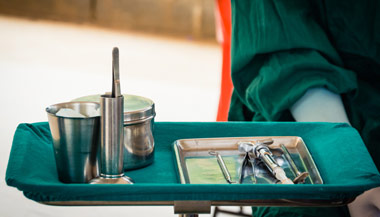Penile Vibratory Stimulation and Electroejaculation
Penile Vibratory Stimulation
Men with spinal cord injury can frequently achieve erection and have sexual intercourse, however the percentage who can successfully ejaculate is very low. Penile vibratory stimulation is an office procedure that is painless and requires no anesthetic or sedation.
- A specially designed mechanical vibrator is placed at the base of the glans penis and it is set a certain frequency and amplitude.
- Men with an intact ejaculatory reflex arc, which is dependent on the level of spinal cord injury, are able to experience reflex ejaculation.
- If enough sperm are able to be collected in the ejaculate, they are washed and processed by the IVF lab and can be used for intrauterine insemination (IUI). IUI involves taking this processed, ejaculated specimen and placing it directly in the uterus of the female partner. IUI is an office procedure performed by the woman’s reproductive endocrinologist. A thin catheter is gently advanced through the opening of the cervix (cervical os) and the sperm are injected into the uterus at the time of ovulation. IUI requires no anesthesia and is similar to a pelvic examination and Pap smear with regard to discomfort.
- Some men with spinal cord injury have poor sperm quality; despite being able to collect ejaculated sperm, they may not be candidates for IUI. In this case, in vitro fertilization and intracytoplasmic sperm injection (IVF/ICSI) are used to carefully inject selected individual sperm in the female partner’s retrieved egg. Once fertilization occurs, the embryo is then transferred into the woman’s uterus.
Electroejaculation
Electroejaculation is another technique that can be used to stimulate ejaculation in men with spinal cord injury who are not responsive to penile vibratory stimulation.
- An electric probe or electroejaculator is inserted into the rectum and positioned against the prostate. Using increasing frequency and amplitude of energy, ejaculation is stimulated.
- The ejaculate is collected from the urethra as well as the bladder, as frequently retrograde ejaculation into the bladder occurs. Because of this, patients are premedicated to adjust the pH of their urine so that sperm can survive in the bladder.
- If enough sperm are able to be collected in the ejaculate, they are washed and processed by the IVF lab and can be used for IUI.
- As was explained above, some men with spinal cord injury have poor sperm quality, and despite being able to collect ejaculated sperm, may not be candidates for IUI. In this case, IVF/ICSI are used to carefully inject selected individual sperm in the female partner’s retrieved egg. Once fertilization occurs, the embryo is then transferred into the woman’s uterus.
- In men with sensation at or below the abdomen, anesthesia may be used.
- Careful monitoring of blood pressure and heart rate is essential as men with spinal cord injury who have a history of autonomic dysreflexia may experience a sudden onset of blood pressure changes.





